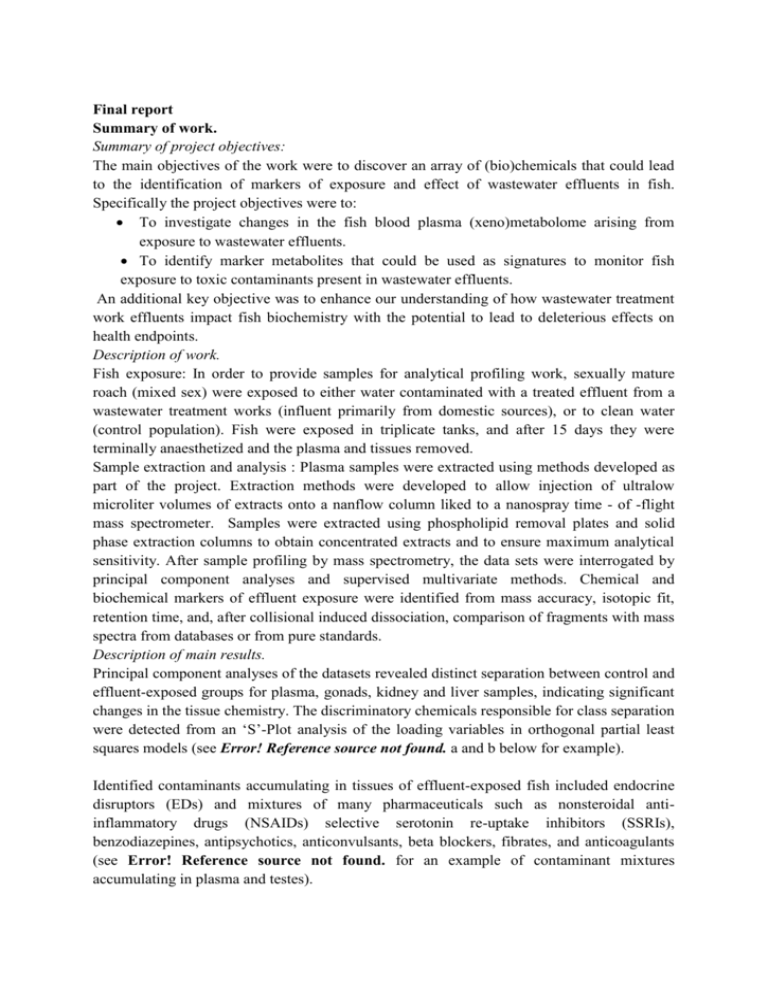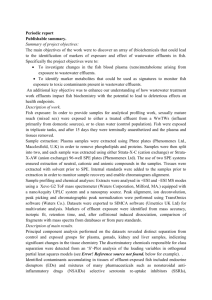final1-ad-mc-final-report-july-22-2014
advertisement

Final report Summary of work. Summary of project objectives: The main objectives of the work were to discover an array of (bio)chemicals that could lead to the identification of markers of exposure and effect of wastewater effluents in fish. Specifically the project objectives were to: To investigate changes in the fish blood plasma (xeno)metabolome arising from exposure to wastewater effluents. To identify marker metabolites that could be used as signatures to monitor fish exposure to toxic contaminants present in wastewater effluents. An additional key objective was to enhance our understanding of how wastewater treatment work effluents impact fish biochemistry with the potential to lead to deleterious effects on health endpoints. Description of work. Fish exposure: In order to provide samples for analytical profiling work, sexually mature roach (mixed sex) were exposed to either water contaminated with a treated effluent from a wastewater treatment works (influent primarily from domestic sources), or to clean water (control population). Fish were exposed in triplicate tanks, and after 15 days they were terminally anaesthetized and the plasma and tissues removed. Sample extraction and analysis : Plasma samples were extracted using methods developed as part of the project. Extraction methods were developed to allow injection of ultralow microliter volumes of extracts onto a nanflow column liked to a nanospray time - of -flight mass spectrometer. Samples were extracted using phospholipid removal plates and solid phase extraction columns to obtain concentrated extracts and to ensure maximum analytical sensitivity. After sample profiling by mass spectrometry, the data sets were interrogated by principal component analyses and supervised multivariate methods. Chemical and biochemical markers of effluent exposure were identified from mass accuracy, isotopic fit, retention time, and, after collisional induced dissociation, comparison of fragments with mass spectra from databases or from pure standards. Description of main results. Principal component analyses of the datasets revealed distinct separation between control and effluent-exposed groups for plasma, gonads, kidney and liver samples, indicating significant changes in the tissue chemistry. The discriminatory chemicals responsible for class separation were detected from an ‘S’-Plot analysis of the loading variables in orthogonal partial least squares models (see Error! Reference source not found. a and b below for example). Identified contaminants accumulating in tissues of effluent-exposed fish included endocrine disruptors (EDs) and mixtures of many pharmaceuticals such as nonsteroidal antiinflammatory drugs (NSAIDs) selective serotonin re-uptake inhibitors (SSRIs), benzodiazepines, antipsychotics, anticonvulsants, beta blockers, fibrates, and anticoagulants (see Error! Reference source not found. for an example of contaminant mixtures accumulating in plasma and testes). a) Metabolites/chemicals increased by effluent exposure b) Quality Control (n=7) Female Control (n=13) Male Control (n=10) Female Exposed (n=16) Male Exposed (n=11) Metabolites decreased by effluent exposure Figure 1: Principal component analysis (a) and ‘S’ scatter plot analysis (b) of the chemical profiles in plasma of roach exposed either to treated WwTW effluent or control water. The samples were profiled in −ESI mode by nUPLC-nESI-TOFMS. Quality control samples were used to monitor the analytical performance of the MS. In the scores plot in a) clear separation was observed between the blood samples from fish exposed to effluent contaminated water compared with fish exposed to clean water. In b) the data from a) was further interrogated to detect the chemical contaminants taken up by fish and also any changes in metabolite profiles as a result of chemical exposure. Class of exposed fish chemicals NSAIDs (diclofenac, mefenamic acid) detected ibuprofen, in naproxen, SSRIs (fluoxetine, norfluoxetine, paroxetine, sertraline, norsertraline, citalopram, venlafaxine) Concentrations Plasma Testes (ng/ml) (ng/g) 0.5 - 43.6 0.1 - 5.2 2.1 - 2.3 0.7- 2.7 Metabolite disruption detected in plasma/testes of effluent-exposed fish 3 fold decrease in prostaglandin E2 levels (p<0.01) 5 fold increase in serotonin metabolite levels e.g. 5-methoxy-tryptophan (p<0.01) 2 fold decrease in androstenedione levels (p<0.05) Other affected pathways: 2-10 fold increases in bile acids, carnitines, and sphinganines EDs (bisphenol A, triclosan, chlorophene, 2.1 - 4.5 0.2 - 13.4 propiconazole) Other xenobiotics (nordiazepam, clozapine, norclozapine, quetiapine, norquetiapine, warfarin, 0.5 - 1.3 0.13 - 2.7 carbamazepine, propranolol, gemfibrozil, clopidogrel Table 1: Chemical contaminants detected in effluent-exposed fish and disruption of metabolite concentrations. Metabolite profiling revealed disturbances in eicosanoid, steroid, serotonin, bile acid, carnitine and sphingosine pathways. Some of these metabolite disruptions can be linked to the presence of types of key chemical stressors in the tissues. For instance, NSAIDs inhibit cyclooxygenase activity and consequently prostaglandin (PG) synthesis; SSRIs modulate the serotonin pathway and EDs can disrupt androgen biosynthesis. Metabolite disruption was apparent although the plasma concentrations of these contaminants were 3-1000 fold below human therapeutic levels indicating possible mixture effects. SSRIs, NSAIDs, and EDs were all detected in the testes, and these classes of compounds are reported to cause endocrine disrupting effects associated with the reproductive axis. This work revealed that using sensitive nontargeted chemical profiling techniques enable detection of contaminant mixtures and disruption of key metabolite pathways in fish tissues. Effluent exposure resulted in disturbance of a number of fundamental signalling pathways in fish; these include widespread reduction of prostaglandins in many tissues and these mediators are important in ion transport, immune function and reproduction. In addition, reduction in androgen and increases in serotonin metabolites were observed, indicating potential effects on reproductive and neurological endpoints. This nontargeted approach could be extremely informative for ecotoxicological investigations on the health effects and associated contaminant mixtures in fish exposed to wastewater effluents. Socio-economic impact and implications This work provides the tools and techniques needed to investigate the impact of contaminated environments on aquatic organisms. It has resulted in findings that indicate the fish in effluent contaminated waters are highly vulnerable to exposure to a number of pharmaceuticals affecting behavioural, immune and reproductive function. The work directly contributes knowledge important for the risk assessment of contaminants in the aquatic environment and is relevant to EU policy and legislation particularly in respect to the Water Framework Directive. The work is disseminated in the following conference presentations and scientific journals: Arthur David. A new approach for high throughput (xeno)metabolomics based on solid phase extraction and nanoflow liquid chromatography-nanoelectrospray ionisation mass spectrometry. Analytical Tools for Cutting-edge Metabolomics – a joint meeting of the Analytical Division of the RSC and the International Metabolomics Society. April 2014, London. Arthur David. High-throughput nanospray metabolomics to identify mixtures of chemical stressors and their effects in fish exposed to wastewater effluents. Society of Environmental Toxicology and Chemistry, SETAC Europe 24th Annual Meeting May 2014, Basel, Switzerland. Evaluation of analytical performance and reliability of direct nanoLC-nanoESI-high resolution mass spectrometry for profiling the (xeno)metabolome. Arthur David, Andrew J. Chetwynd, Elizabeth M. Hill and Alaa Abdul-Sada. Journal of Mass Spectrometry. July 2014. in press. A new approach for plasma (xeno)metabolomics based on solid phase extraction and nanoflow liquid chromatography-nanoelectrospray ionisation mass spectrometry. Arthur David, Alaa Abdul-Sada, Raghad Al-Salhi, Anke Lange, Charles R. Tyler, and Elizabeth M. Hill. Journal of Chromatography A. July 2014 in press. Uptake of contaminant mixtures and disruption of fish metabolism as a result of exposure to wastewater effluents: relevance for identification of health endpoints. Arthur David, Alaa Abdul-Sada, Anke Lange, Charles R. Tyler, and Elizabeth M. Hill. Environmental Science and Technology. July 2014 in preparation.









